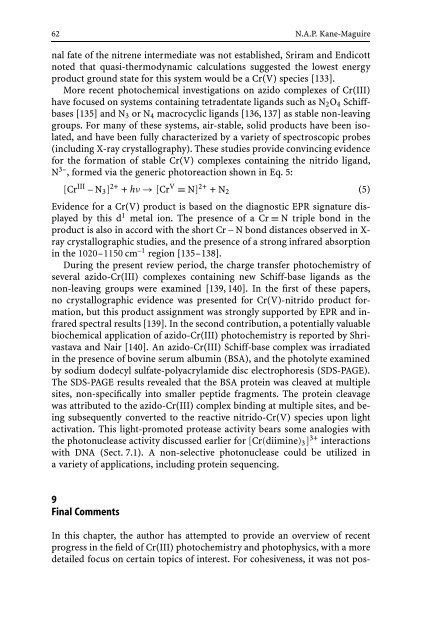Photochemistry and Photophysics of Coordination Compounds
Photochemistry and Photophysics of Coordination Compounds
Photochemistry and Photophysics of Coordination Compounds
Create successful ePaper yourself
Turn your PDF publications into a flip-book with our unique Google optimized e-Paper software.
62 N.A.P. Kane-Maguire<br />
nal fate <strong>of</strong> the nitrene intermediate was not established, Sriram <strong>and</strong> Endicott<br />
noted that quasi-thermodynamic calculations suggested the lowest energy<br />
product ground state for this system would be a Cr(V) species [133].<br />
More recent photochemical investigations on azido complexes <strong>of</strong> Cr(III)<br />
have focused on systems containing tetradentate lig<strong>and</strong>s such as N2O4 Schiffbases<br />
[135] <strong>and</strong> N3 or N4 macrocyclic lig<strong>and</strong>s [136, 137] as stable non-leaving<br />
groups. For many <strong>of</strong> these systems, air-stable, solid products have been isolated,<br />
<strong>and</strong> have been fully characterized by a variety <strong>of</strong> spectroscopic probes<br />
(including X-ray crystallography). These studies provide convincing evidence<br />
for the formation <strong>of</strong> stable Cr(V) complexes containing the nitrido lig<strong>and</strong>,<br />
N3– , formed via the generic photoreaction shown in Eq. 5:<br />
[CrIII – N3] 2+ + hν → [CrV ≡ N] 2+ +N2<br />
(5)<br />
Evidence for a Cr(V) product is based on the diagnostic EPR signature displayed<br />
by this d1 metal ion. The presence <strong>of</strong> a Cr ≡ Ntriplebondinthe<br />
product is also in accord with the short Cr – N bond distances observed in Xray<br />
crystallographic studies, <strong>and</strong> the presence <strong>of</strong> a strong infrared absorption<br />
in the 1020–1150 cm –1 region [135–138].<br />
During the present review period, the charge transfer photochemistry <strong>of</strong><br />
several azido-Cr(III) complexes containing new Schiff-base lig<strong>and</strong>s as the<br />
non-leaving groups were examined [139, 140]. In the first <strong>of</strong> these papers,<br />
no crystallographic evidence was presented for Cr(V)-nitrido product formation,<br />
but this product assignment was strongly supported by EPR <strong>and</strong> infrared<br />
spectral results [139]. In the second contribution, a potentially valuable<br />
biochemical application <strong>of</strong> azido-Cr(III) photochemistry is reported by Shrivastava<br />
<strong>and</strong> Nair [140]. An azido-Cr(III) Schiff-base complex was irradiated<br />
in the presence <strong>of</strong> bovine serum albumin (BSA), <strong>and</strong> the photolyte examined<br />
by sodium dodecyl sulfate-polyacrylamide disc electrophoresis (SDS-PAGE).<br />
The SDS-PAGE results revealed that the BSA protein was cleaved at multiple<br />
sites, non-specifically into smaller peptide fragments. The protein cleavage<br />
was attributed to the azido-Cr(III) complex binding at multiple sites, <strong>and</strong> being<br />
subsequently converted to the reactive nitrido-Cr(V) species upon light<br />
activation. This light-promoted protease activity bears some analogies with<br />
the photonuclease activity discussed earlier for [Cr(diimine)3] 3+ interactions<br />
with DNA (Sect. 7.1). A non-selective photonuclease could be utilized in<br />
a variety <strong>of</strong> applications, including protein sequencing.<br />
9<br />
Final Comments<br />
In this chapter, the author has attempted to provide an overview <strong>of</strong> recent<br />
progress in the field <strong>of</strong> Cr(III) photochemistry <strong>and</strong> photophysics, with a more<br />
detailed focus on certain topics <strong>of</strong> interest. For cohesiveness, it was not pos-

















